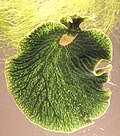A chloroplast (/ˈklɔːrəˌplæst, -plɑːst/) is a type of membrane-bound organelle known as a plastid that conducts photosynthesis mostly in plant and algal...
194 KB (18,813 words) - 08:06, 14 June 2024
ribosomal proteins tRNAs nicotiana tabacum edit · image Chloroplast DNA Interactive gene map of chloroplast DNA from Nicotiana tabacum. Segments with labels...
54 KB (5,883 words) - 08:32, 30 May 2024
Chloroplasts contain several important membranes, vital for their function. Like mitochondria, chloroplasts have a double-membrane envelope, called the...
6 KB (805 words) - 03:07, 28 November 2023
Chloroplast capture is an evolutionary process through which inter-species hybridization and subsequent backcrosses yield a plant with new genetic combination...
3 KB (336 words) - 17:41, 3 January 2024
Photosynthetic pigment (redirect from Pigments in Chloroplast)
photosynthetic pigment (accessory pigment; chloroplast pigment; antenna pigment) is a pigment that is present in chloroplasts or photosynthetic bacteria and captures...
4 KB (406 words) - 05:48, 24 June 2024
Intermembrane space (redirect from Chloroplast intermembrane space)
between the inner membrane and the outer membrane of a mitochondrion or a chloroplast. It also refers to the space between the inner and outer nuclear membranes...
10 KB (1,065 words) - 18:50, 12 November 2023
Thylakoids are membrane-bound compartments inside chloroplasts and cyanobacteria. They are the site of the light-dependent reactions of photosynthesis...
37 KB (4,369 words) - 21:49, 8 May 2024
in the chloroplast of a eukaryotic cell, that is, protein complexes that facilitate the transfer of proteins in and out through the chloroplast's membrane...
5 KB (492 words) - 23:50, 26 January 2022
Hill reaction (section Chloroplasts in vitro)
proven by British biochemist Robin Hill. He demonstrated that isolated chloroplasts would make oxygen (O2) but not fix carbon dioxide (CO2). This is evidence...
9 KB (1,014 words) - 03:32, 31 March 2024
collectively known as "algae" have unique organelles known as chloroplasts. Chloroplasts are thought to be descended from cyanobacteria that formed endosymbiotic...
137 KB (14,760 words) - 23:55, 11 July 2024
botany, refers to the colorless fluid surrounding the grana within the chloroplast. Within the stroma are grana (stacks of thylakoid), the sub-organelles...
2 KB (197 words) - 22:04, 27 May 2023
takes place in organelles called chloroplasts. A typical plant cell contains about 10 to 100 chloroplasts. The chloroplast is enclosed by a membrane. This...
110 KB (11,795 words) - 22:17, 12 July 2024
N-terminus (section Chloroplast targeting peptide)
mitochondrion. The N-terminal chloroplast targeting peptide (cpTP) allows for the protein to be imported into the chloroplast. Protein N-termini can be modified...
7 KB (749 words) - 23:10, 30 March 2024
episode of symbiogenesis with a cyanobacterium created the plants, with chloroplasts. Eukaryotic cells contain membrane-bound organelles such as the nucleus...
61 KB (6,073 words) - 18:38, 10 July 2024
have primary chloroplasts derived from endosymbiotic cyanobacteria. Diatoms and brown algae are examples of algae with secondary chloroplasts derived from...
91 KB (10,509 words) - 15:43, 22 May 2024
Chloroplast Sensor Kinase (CSK) is a protein in chloroplasts and cyanobacteria, bacteria from which chloroplasts evolved by endosymbiosis. It is part of...
3 KB (399 words) - 11:52, 4 April 2024
Mougeotia (section Chloroplast movement)
has one or two flat, rectangular and ribbon-shaped chloroplasts that fill the cell. Chloroplasts are able to twist in response to light conditions. The...
14 KB (1,533 words) - 10:00, 13 August 2023
intracellular endosymbiotic cyanobacteria. Examples of plastids include chloroplasts (used for photosynthesis); chromoplasts (used for synthesis and storage...
28 KB (3,216 words) - 17:15, 11 July 2024
Etioplast (section Transition to chloroplast)
from proplastids that have not been exposed to light, and convert into chloroplasts upon exposure to light. They are usually found in stem and leaf tissue...
4 KB (474 words) - 22:19, 20 August 2023
Pyrenoids are sub-cellular micro-compartments found in chloroplasts of many algae, and in a single group of land plants, the hornworts. Pyrenoids are associated...
27 KB (3,381 words) - 06:17, 11 June 2024
cells. They are non-pigmented, in contrast to other plastids such as the chloroplast. Lacking photosynthetic pigments, leucoplasts are located in non-photosynthetic...
3 KB (308 words) - 22:14, 25 November 2023
CoRR hypothesis (section Chloroplasts and mitochondria)
bioenergetic organelles". Chloroplasts and mitochondria are energy-converting organelles in the cytoplasm of eukaryotic cells. Chloroplasts in plant cells perform...
10 KB (1,255 words) - 04:18, 1 October 2022
chemiosmosis occurs in mitochondria and chloroplasts, as well as in most bacteria and archaea. For instance, in chloroplasts during photosynthesis, an electron...
24 KB (3,154 words) - 06:26, 9 June 2024
prokaryotic organisms. The theory holds that mitochondria, plastids such as chloroplasts, and possibly other organelles of eukaryotic cells are descended from...
70 KB (7,517 words) - 04:34, 1 July 2024
Sacoglossa, the sap-sucking sea slugs. Some members of this group use chloroplasts from the algae they eat for photosynthesis, a phenomenon known as kleptoplasty...
19 KB (2,187 words) - 08:32, 26 June 2024
photosynthetic. This means that they obtain their energy from sunlight, using chloroplasts derived from endosymbiosis with cyanobacteria to produce sugars from...
95 KB (8,045 words) - 22:02, 10 July 2024
organelles including mitochondria, which provide energy for cell functions; chloroplasts, which create sugars by photosynthesis, in plants; and ribosomes, which...
60 KB (6,271 words) - 17:58, 10 July 2024
Light-dependent reactions (section In chloroplasts)
(plastoquinone in chloroplasts; ubiquinone in mitochondria) and transfer them to a mobile, water-soluble electron carrier (plastocyanin in chloroplasts; cytochrome...
28 KB (3,452 words) - 22:04, 10 April 2024
for molecular biology, especially studies of flagellar motility and chloroplast dynamics, biogenesis, and genetics. One of the many striking features...
10 KB (1,060 words) - 16:22, 13 June 2024
are imported to the stromal compartment of chloroplasts from the cytosol by crossing the outer chloroplast membrane. The enzymatically active substrate...
59 KB (6,522 words) - 20:15, 18 May 2024























